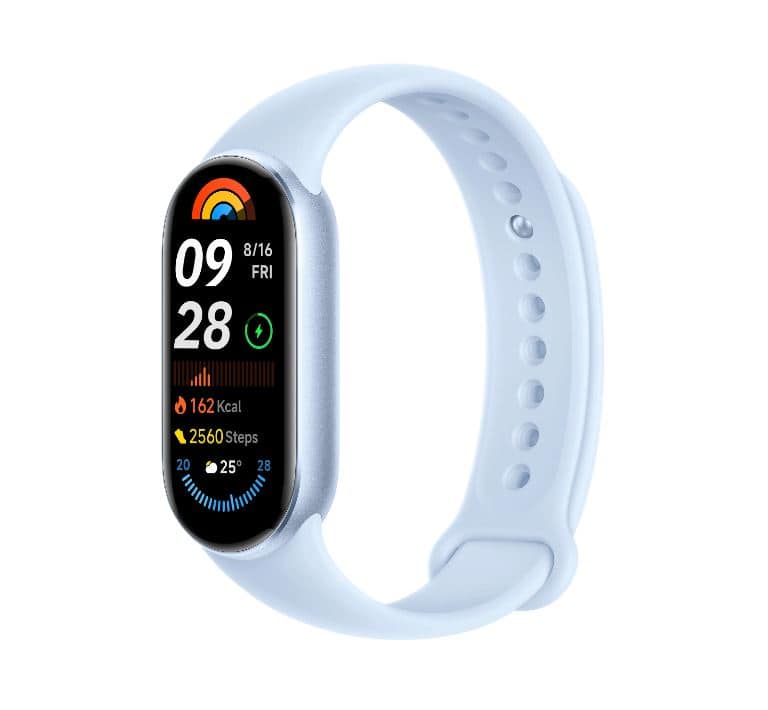Xiaomi is reportedly gearing up to launch its latest wearable device, the Smart Band 9 Pro, only a short time after debuting the Smart Band 9. Although the previous model was released relatively recently, new leaked images suggest that the Smart Band 9 Pro is nearing its introduction to the market.
In terms of design, the new model shows only slight alterations when compared to its predecessor, the Band 8 Pro. The most significant difference noted in the renders is the transition to a subtly curved display, moving away from the flat screen of the previous version. Furthermore, the strap design has been polished, featuring a clasp positioned nearer to the end—similar to the signature look of the Apple Watch. The device retains its characteristic rounded button, which will still serve for navigation.
Aesthetic changes also extend to the frame. The Band 9 Pro opts for a refined matte finish instead of the shiny metal style of the Band 8 Pro. Additionally, indications suggest a larger display complemented by slimmer bezels, although exact dimensions are yet to be disclosed.
The Smart Band 9 Pro is expected to be available in at least three color options: silver, black, and gold, with potential for more. Though specifications remain unconfirmed, it’s anticipated that functions like health tracking, GPS capabilities, and seamless app integration will carry over from the previous model, potentially with enhancements.
The Impact of Wearable Technology on Modern Lives
The introduction of wearable technology like Xiaomi’s Smart Band 9 Pro goes beyond mere consumer interest; it influences the daily lives of individuals, the dynamics of communities, and even the overall healthcare landscape of countries.
Health Monitoring and Lifestyle Changes
Wearable devices like fitness trackers and smart bands have transformed how people monitor their health. With features such as heart rate monitoring, sleep tracking, and activity logging, individuals are empowered to take charge of their wellness. Studies have shown that people who use wearables tend to be more active and health-conscious. For instance, a report from the Journal of Medical Internet Research indicates that users of fitness trackers may increase their physical activity levels by as much as 30%.
Community Engagement Through Shared Goals
In communities, the rise of wearables has fostered a culture of collective health goals. Groups can set challenges, share achievements, and motivate each other to remain active. This communal approach not only enhances individual commitment but also strengthens community ties, particularly among younger populations who find motivation in social interactions.
Controversies Around Data Privacy
As wearable technology continues to advance, concerns surrounding data privacy and security come to the forefront. Many users are unaware of how their personal health data is being used or shared by companies. Reports of data breaches have raised eyebrows, causing users to question if the benefits outweigh the potential risks. This controversy has spurred calls for clearer regulations and better practices regarding user consent and data protection.
The Global Health Economy
On a larger scale, countries are benefiting from the integration of wearable technology into public health strategies. Governments and healthcare organizations are exploring ways to utilize data from wearables for public health monitoring and research. For instance, during the COVID-19 pandemic, some health officials tapped into wearables’ data to track symptoms and aid in contact tracing. As nations globally continue to face health crises, the data gleaned from wearables could play a crucial role in managing public health responses.
Increased Accessibility and Innovation
As wearable technology becomes more sophisticated, it also grows more affordable. Companies like Xiaomi are contributing to the democratization of health tech by creating budget-friendly alternatives to high-end devices. This trend ensures that large segments of the population can access health-monitoring technologies, potentially improving overall public health metrics.
In conclusion, the effects of advancements in wearable technology reach far beyond the individual user. They shape community interactions, drive changes in public health approaches, and stimulate discussions about privacy and data management. As manufacturers like Xiaomi continue to innovate and expand their product offerings, the implications for personal, community, and national health will only grow more significant.
For more information on the impact of technology on health, visit World Health Organization.
The article has been updated: 2024-10-31 18:00
Here are some suggested related links for the post title “Xiaomi Prepares for Release of Smart Band 9 Pro”:
1. Xiaomi Official Website – Visit Xiaomi’s official site for the latest updates and product releases directly from the brand.
2. GSMArena – A reliable source for mobile and tech news, offering detailed reviews and comparisons for smart devices including wearables.
3. TechCrunch – Stay informed with technology news and insights, covering the latest announcements from Xiaomi and other tech companies.
4. The Verge – Provides in-depth articles and news on technology, including smart bands and wearable devices.
5. Android Authority – Features news, reviews, and guides related to Android devices, including Xiaomi’s product announcements and reviews.
6. CNET – Offers reviews, articles, and the latest news on gadgets and tech products, including wearables like the Xiaomi Smart Band series.
7. Tom’s Guide – A destination for technology reviews and buying guides, from smart bands to other fitness tech.
8. Engadget – A comprehensive source for gadgets and consumer electronics news, including smart bands and wearable technology updates.
These links will provide readers with additional context and related content surrounding the Xiaomi Smart Band 9 Pro.
The article has been updated: 2024-11-02 05:30
What features can we expect from the upcoming Xiaomi Smart Band 9 Pro?
The Xiaomi Smart Band 9 Pro is expected to come with several upgraded features, including a larger and higher-resolution display, enhanced health and fitness tracking capabilities, improved battery life, and potentially new workout modes. Additionally, users can anticipate advanced sleep tracking and health monitoring features, such as heart rate and SpO2 levels. With these enhancements, the Smart Band 9 Pro aims to provide a more comprehensive fitness experience and compete effectively in the wearables market.



















